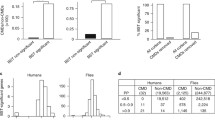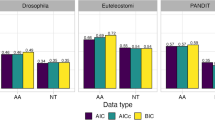Abstract.
Parsimony is commonly used to infer the direction of substitution and mutation. However, it is known that parsimony is biased when the base composition of the DNA sequence is skewed. Here I quantify this effect for several simple cases. The analysis demonstrates that parsimony can be misleading even when levels of sequence divergence are as low as 10%; parsimony incorrectly infers an excess of common to rare changes. Caution must therefore be excercised in the use of parsimony.
Similar content being viewed by others
Author information
Authors and Affiliations
Additional information
Received: 13 November 1997 / Accepted: 18 June 1998
Rights and permissions
About this article
Cite this article
Eyre-Walker, A. Problems with Parsimony in Sequences of Biased Base Composition. J Mol Evol 47, 686–690 (1998). https://doi.org/10.1007/PL00006427
Issue Date:
DOI: https://doi.org/10.1007/PL00006427




